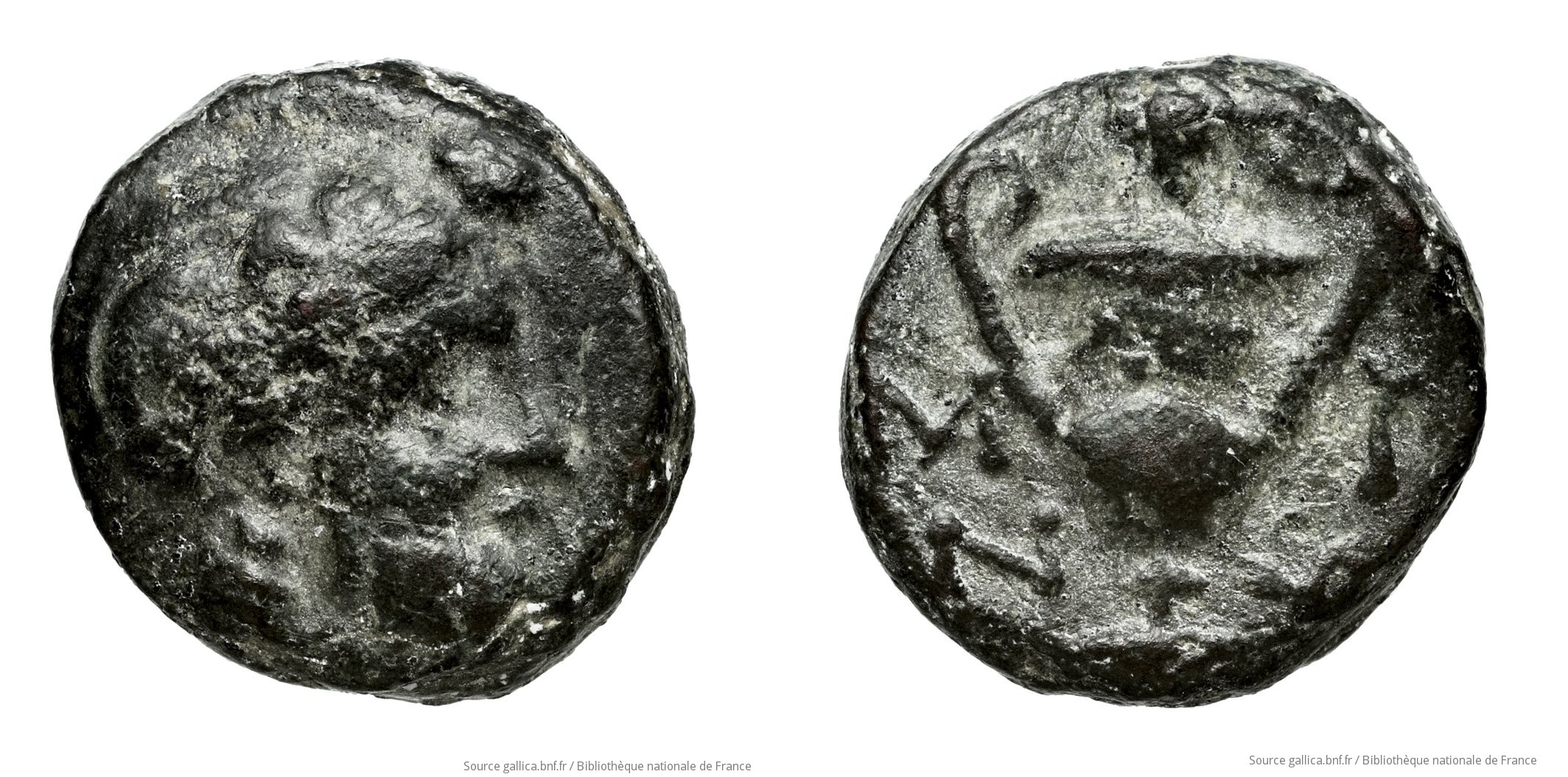S 523 - Minoa, bronze (Dionysus/cantharus) (220-180 BCE)
From SILVER
220 BCE - 180 BCE Bronze
Description
| ObverseInscription or printing placed on the obverse.: | (Bearded head of Dionysos right, wreathed with ivy; in some cases M behind the head.). |
| ReverseInscription or printing placed on the reverse.: | MINΩ (Greek).Kantharos, above bunch of grapes. |
Mint and issuing power
| MintIdentifies the place of manufacture or issue of a numismatic object.: | Minoa | Ancient regionAncient region.: | Cyclades | Modern countryModern country: Greece | AuthorityIdentifies the issuing power. The authority can be "pretended" when the name or the portrait of X is on the coin but he/she was not the issuing power. It can also be "uncertain" when there is no mention of X on the coin but he/she was the issuing power according to the historical sources: |
Chronology
| FromIdentifies the initial date in a range assigned in a numismatic context. | 220 BCE | toIdentifies the final date in a range assigned in a numismatic context.. | 180 BCE | PeriodTime period of the numismatic object.: Hellenistic 323-30 BC |
Physical description
| MetalThe physical material (usually metal) from which an object is made.: | Bronze |
Median weightMedian of the weights of numismatic objects (in grams). in grams | 3.60 | DenominationTerm indicating the value of a numismatic object. Examples: tetradrachm, chalkous, denarius.: | Module B | StandardStandard.: |
Image

S_523_-_Minoa, _bronze_(Dionysus-cantharus)_(220-180_BCE).png [1]
References
| Die study referencePublication of the study: | Liampi 20041Liampi 2004, p. 104, n° 39-41 | ||
| Coin series referenceReference to coin series study: | Sear I2Sear I, n° 3069 | ||
Obverse dies distribution
| FrequencyFrequency of specimen in distribution. ᵖ | Number of obversesNumber of obverse dies. ᵖ (o) | % (o) | Number of coinsNumber of coins. (n) | % (n) | Die nameName(s) of the die(s). |
| 1 | 1 | 50 | 1 | 7.69 | 1 |
| 12 | 1 | 50 | 12 | 92.31 | 2 |
| Total | 2 of 2 | 100 | 13 of 13 | 100 |
Reverse dies distribution
no distribution is available
Quantification
| Number of obversesNumber of obverse dies. ᵖ (o) | 2 | Number of singletons (o1)The number of singleton coins. ᵖ | 1 |
| Number of reverse diesNumber of reverse dies. (r) | 3 | Number of coinsNumber of coins. (n) | 13 |
| Coins per obverse dieNumber of coins per obverse die. (n/o) | 6.5 | Coins per reverse dieNumber of coins per reverse die. (n/r) | 4.33 |
| Reverse per obverse ratioRatio of obverse dies divided by reverse dies. (r/o) | 1.5 | Percentage of singletons (o1)number of coins (n) divided by the number of singletons (o1) ᵖ | 50 % |
| Original number of dies (O) (Carter 1983 formula)The estimation of the number of coins according to Carter 1983 ᵖ | 2.13 | Coins struck if 20,000 as average productivity per dieCoins made if the average productivity for obverses (according to Carter) is 20,000. ᵖ | 42,600 |
| Original number of dies (O) (Esty 2011 formula)The estimation of the number of coins according to the singleton formula in Esty 2011 ᵖ (O) | 2.36 | Survival rate if 20,000 as average productivity per dieSurvival rate if average productivity is 20,000. ᵖ | 0.00031 |
| Coverage (o = % of O) (Esty 1984 formula)Esty 1984 - coverage (% of O) ᵖ (o = % of O) | 92.31% | Die productivity if survival rate 1/2,000Average productivity if survival rate is 1/2,000. ᵖ | 12,206.57 |
| Weight of silver (in kg) if 20,000 coins per die (O = Carter formula)Carter 1983 * Median weight * 20000 (*10 if gold or electrum) ᵖ | n.a. | Die productivity if survival rate 1/5,000Average productivity if survival rate is 1/5,000. ᵖ | 30,516.43 |
Remarks
Most likely one single workstation